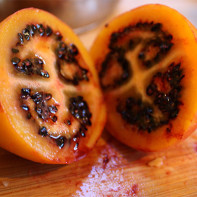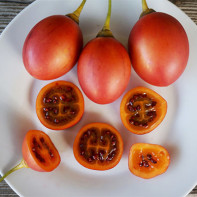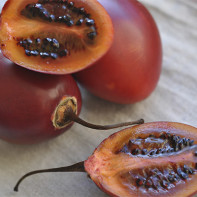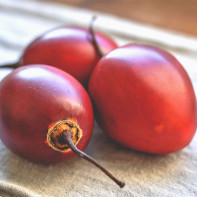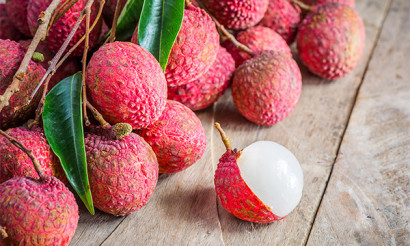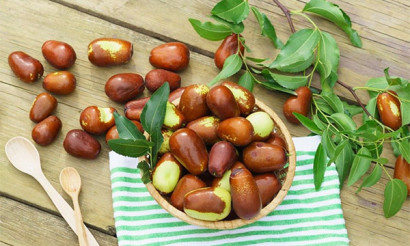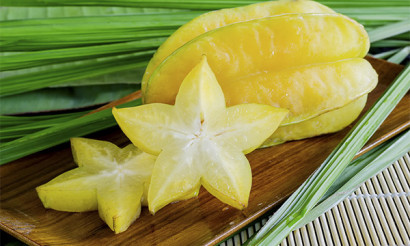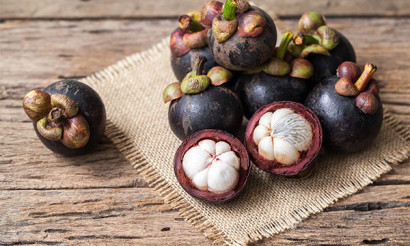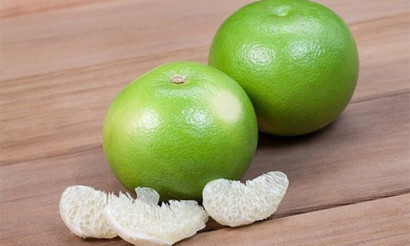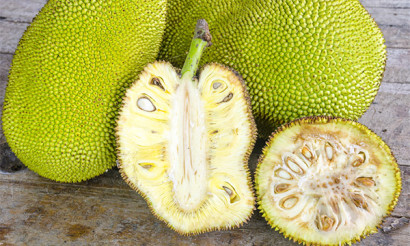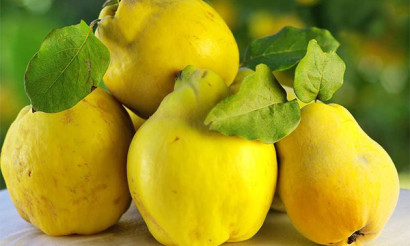Fruit tamarillo: useful properties and contraindications
On the shelves of stores today you can find many different fruits. One of the striking representatives is the tamarillo. In appearance, the fruit resembles a tomato, but has a very surprising taste.
- What is a tamarillo
- What it looks like
- Where it grows
- Types
- Composition and calories
- Useful properties of the tamarillo fruit
- General benefits
- For women
- For Men
- In Pregnancy
- Breastfeeding
- For kids
- For weight loss
- Health Hazards and Contraindications
- How to choose and store
- How to eat tamarillo properly
- How to peel
- Cooking applications
- Jam
- Galette
- Warm Salad
- Tamarillo in batter
- Can be grown at home
- Interesting Facts
What is tamarillo
The fruit is also called the fruit of the tomato tree. Until recently, it was not known in Russia. Its unusual taste could only be appreciated by those who have been abroad. But today the amazing fruit can be found in supermarkets.
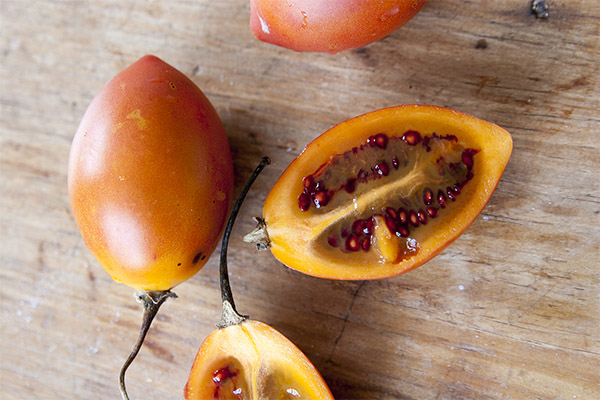
What does it look like
Tamarillo grows on trees that reach a height of 6 meters. Such a plant lives about 15 years. The leaves of the tree are large, elongated. Despite its size, the trunk can easily break from a strong gust of wind. The fruits are formed in bunches after the pink and white flowers, which have a pleasant fragrance, have bloomed.
The tamarillo resembles a tomato in appearance. Its length does not exceed 10 cm. The diameter of the fruit is only 5 cm. The surface is soft and smooth, the fruit has an egg shape. The flesh of the amazing fruit can be different depending on the variety and degree of maturity. More often you can find tamarillo with orange, yellow or red flesh. The seeds resemble tomato seeds, but are slightly larger in size. The skin is dense, tastes bitter, and is always uniformly colored. The flesh is quite tasty, but characterized by a slight sourness.
Where does it grow
The tamarillo plant grows exclusively in warm countries closer to the equator. It needs a tropical climate that allows the fruit to ripen quickly, gaining sweetness and flavor. You can find this fruit in New Zealand. It is this country is considered the best exporter.
Types
Today there are three main types of the fruit. They differ not only in appearance, color, but also in taste:
- Orange. It is also called golden. The fruits of the tomato tree of this variety are distinguished by juicy, fleshy flesh, and are the largest of all species.
- Red. This is the most popular variety, which has a beautiful and harmonious taste. Most of all, it is felt when the fruit is consumed fresh. The flesh contains red seeds, but the fruit itself is orange. The skin, depending on ripeness, can have any shade of red. Because of its unusual and pleasant color, the product is most often used as a decoration for various dishes.
- Yellow. The peel and flesh of the fruit have a yellow color. In taste, the tamarillo resembles a tomato, only sweeter. The fruit is also similar in appearance to the vegetable.
For the first sample, it is recommended to choose red fruits, as they have a more pronounced taste.
Composition and calories
The fruit has in its composition a large number of useful trace elements and vitamins. Its composition includes:
- B vitamins. A large group that includes many vitamins. Each of them has a positive effect on certain systems and organs. Thus, the use of tamarillo will help support the nervous system, gastrointestinal tract, and eyesight.
- Vitamin A. Also required for immune function, supports the proper functioning of the nervous system, and is necessary for energy metabolism.
- Ascorbic acid. Vitamin C is necessary for the proper functioning of the body's defenses. It helps maintain immunity, cope with colds, and reduce the risk of complications from various pathologies.
- Vitamin PP. It is called nicotinic acid. Needed to support the nervous system. It plays a role in oxidation processes, helps to prevent the accumulation of harmful cholesterol as well as the formation of plaques (they can cause strokes and heart attacks).
- Vitamin E. There are cells in the body that have a negative effect. In medicine they are called free radicals. It is vitamin E that destroys them, protecting the body from their harmful effects. In addition, the substance is involved in the process of restoration of cell membranes.
- Iron. This mineral is necessary for the process of hematopoiesis. Its deficiency causes the development of anemia. Such a disorder leads to a general worsening of health, regular darkening of the eyes when suddenly changing position, nausea, and weakness. In severe cases fainting may occur.
- Potassium. The body needs this substance to maintain intracellular pressure by maintaining the correct sodium-potassium balance.
- Calcium. The fruit contains a large amount of calcium, which is necessary for bone structure. It is this that is an important component of bone tissue. Therefore, the fruit is recommended in the presence of diseases of the musculoskeletal system associated with the destruction of bones.
- Magnesium. The trace element is required for the proper functioning of the cardiovascular system. Magnesium in tamarillo is contained in sufficient quantities, which is beneficial for the heart.
- Glucose. Depending on the variety, it contains sugar in varying amounts. It helps support brain function.
- Phosphorus. The most important trace element, without which no chemical reaction in the body takes place. It is also necessary for bone tissue. Lack of phosphorus causes a lot of diseases and disorders.
Tamarillo is not only a fruit with an amazing taste, but also a real treasure trove of useful substances. Consumption of the fruit in sufficient quantities will have a beneficial effect on the body.
In addition to the rich composition, tamarillo allows you to maintain a figure due to the low level of calories. There are only 50 kcal per 100 g of the product. This allows you to include the fruit in the diet of many diets aimed at losing weight.
Useful properties of the tamarillo fruit
General benefits
The fruit of the tomato tree brings invaluable benefits to the body due to its composition. The beneficial properties of the fruit include:
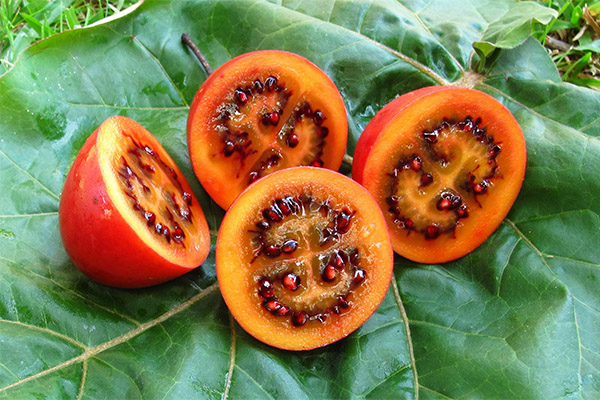
- Maintenance of the nervous system. This is due to the presence of B vitamins in its composition.
- Strengthening the immune system. Tamarillo contains a sufficient amount of vitamin C. Ascorbic acid is considered an important element for immunity. Thus, the fruit will be useful for colds, flu, acute respiratory infections, as well as for prevention.
- Elimination of constipation. The fruit contains a sufficient amount of fiber, which helps to cope with stagnation in the intestines.
- Strengthening of bones and teeth. Tamarillo is known for its sufficient calcium content, which is indispensable and the main building material of bone tissue.
- Maintenance of the cardiovascular system. The fruit contains magnesium, without which the work of the heart muscle is impaired. Cardiologists recommend their patients to definitely include the fruit in their diet.
- Reducing the risk of cancer. This is achieved due to the presence of antioxidants in the composition.
- Increasing the level of hemoglobin. Iron deficiency leads to anemia, which can adversely affect the general condition and cause the development of certain disorders in the fetus during pregnancy. Hemoglobin is maintained by the fetus' iron content.
- Elimination of edema. Such a property is due to the presence of sodium in the composition, which maintains the necessary balance.
- Cleansing of the intestines. Such a property is due to the presence in the composition of fiber and trace elements, which have a beneficial effect on the digestive tract.
Such a fruit as tamarillo has invaluable benefits for the body due to the content of important trace elements and vitamins. Its use can improve the condition of the skin, hair, nails, support the immune system and replenish the necessary substances for the body.
For women
Tamarillo is useful for women's bodies, because it contains a large number of vitamins. They have a positive effect on the condition of the skin, hair and nails. In addition, the fruit contains calcium, which is the building material for the bones, which helps to reduce the risk of joint diseases associated with the destruction of their tissue.
Tamarillo also contains B vitamins, which have a positive effect on the nervous system. Women more often than men are subject to stress, and the use of the fruit will help restore and maintain a normal psychoemotional state.
For men
According to statistics, men most often suffer from diseases of the cardiovascular system. In tamarillo there is magnesium in sufficient quantities. It helps support heart function and reduce the risk of heart attacks and strokes.
The fruit of the tomato tree also helps prevent the formation of cholesterol plaques that begin to form on the walls of blood vessels. They gradually block the lumen, impairing blood circulation. As a result, the heart suffers and the risk of acute malfunctioning increases. Thus, tamarillo will benefit the male body as well.
When pregnant
During the period when a woman is expecting a child, it is important for her to responsibly approach her diet. This is due to the fact that many products can cause negative consequences for the baby in the future.
Specialists recommend to be sure to include fruits in your diet, including tamarillo. But it should be eaten with caution, in small quantities, as well as other products. Such an approach to nutrition will help to eliminate the occurrence of intolerance in the child.
Consumption of the fruit of the tomato tree during pregnancy will help a woman maintain her immune system, which is weakened, and reduce the risk of colds.
Also tamarillo helps to cope with constipation due to its fiber content. In pregnancy, women are often prone to the occurrence of intestinal congestion.
When breastfeeding
The lactation period is an important period in the life of the baby and the mother. A woman needs to be even more careful in her choice of food, because everything that the mother eats goes into the breast milk.
Tamarillo can be eaten during lactation even one year after the birth of the baby. The fruit should be eaten in small quantities, watching the reaction of the baby.
The benefit of tamarillo while breastfeeding is the high content of vitamins and minerals, which help to support the immune system. There is also calcium in the fruit, which is necessary to strengthen the bones of the child.
For children
Experts recommend giving tamarillo to children from the age of 10 years. This will help avoid a negative reaction to the fruit in the form of allergies. It may appear in the form of rash, itching on the skin, redness, irritation. In rare cases, nausea may be observed.
In other cases, the fruit of the tomato tree will bring invaluable benefits for the child's body. It contains calcium, which is necessary for strengthening bones and teeth. In addition, tamarillo is known for its sufficient content of vitamin C, which is essential for maintaining immunity, speeding up the healing process and reducing the risk of complications in the presence of colds.
When losing weight
Nutritionists recommend including tamarillo in your diet when following certain diets aimed at losing and maintaining weight. This is due to the fact that the fruit contains a sufficient number of essential vitamins and trace elements. At the same time, the fruit belongs to the low-calorie products. 100 g of fruit contains only 50 kcal, which does not affect the figure.
Fruits will help not only to maintain weight, but also to replenish the necessary substances, avoiding the negative consequences that can occur with the constant adherence to a strict diet.
Harms and contraindications
Like any fruit, tamarillo may not always bring benefits to the body. Experts do not recommend consuming the fruit in the presence of individual intolerance to the product, allergies to it. This is due to the fact that serious consequences can occur.
Also with caution consume the fruit of the tomato tree should be used during pregnancy and lactation, having previously consulted a doctor.
It is important not to overeat, since excessive consumption can lead to allergic reactions and intolerance. Fetal allergy appears as a rash, redness, swollen skin, runny nose or cough. In severe cases, the manifestation of Quincke's edema or anaphylactic shock is possible.
Specialists warn that the fruit of the tomato tree should be eaten with caution in the presence of diabetes, because it contains a sufficient amount of carbohydrates and glucose.
Consult a doctor before consuming the product should also be consulted in the case of gastritis, colitis. This is due to the fact that tamarillo can irritate the walls of the intestine, have a negative effect on the mucosa of the stomach. Most often it is recommended to consume the product in stewed or steamed form.
Otherwise, if tamarillo is consumed correctly and in small quantities, the product will not harm the body.
How to choose and store
A few years ago, not many people knew about such a product as tamarillo. Today it can be found in large supermarkets. It is not difficult to choose the tastiest fruit. In order to do this, it is necessary to follow a number of simple rules:
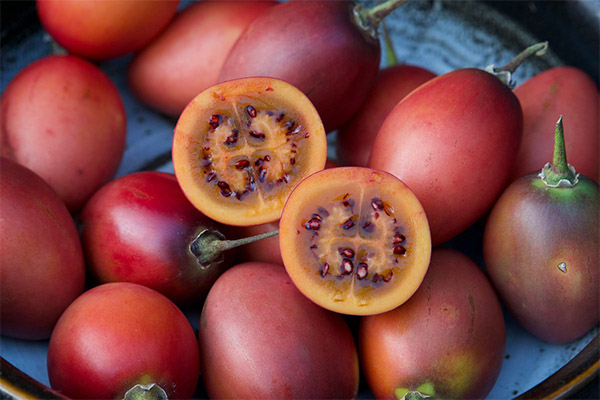
- There must not be any damage on the surface. Through them bacteria penetrate into the flesh, and the product begins to spoil quickly.
- The skin should have an even color, without dents.
- Also note the stalk. It should fit tightly into the surface of the fruit.
- The ripe fruit tends to recover after light pressure. If there is a dent in the pulp, such a fruit should not be chosen.
- Of great importance is also the producer. The most delicious, quality fruits come from New Zealand.
It is important to remember that the color of the pulp does not always indicate the ripeness of the tamarillo. It can be red, orange or yellow depending on the variety.
Store the product for 10 days in the refrigerator, in the compartment for fruit and vegetables. In cases where the fruit is unripe, it can be put in a dark and warm place. Tamarillo can also be frozen. In this case, the fruit should be peeled. Even after freezing the fruit does not lose its useful properties.
How to eat tamarillo properly
Use the fruit mainly as part of dishes such as sauces, salads and desserts. The product is excellent as a topping for pizza, an additive to meat dishes, soups. Tamarillo is also used to make extraordinarily delicious sandwiches.
The fruit of the tomato tree is used in cooking for making juice, mousse, marmalade and other desserts. It is also consumed fresh. In this case, it should be properly prepared.
How to peel
Before eating or cooking tamarillo, you must remove its skin, because it does not taste good and is quite tough. To do this without difficulty, the fruit is dipped in boiling water for a few minutes. After that you scrape off the skin.
If the fruit is eaten fresh, you can cut it in half and use a spoon to scrape off the flesh. This way you will be left with only the skin.
Culinary applications
The fruit has found widespread use in cooking due to its unusual taste. It is used not only for desserts, but also for the preparation of first, second courses, appetizers, salads.
Jam
From tamarillo, as well as any fruit, you can make jam, which will be a great addition to pancakes, pancakes. To make it you will need:
- 450 g of fruit;
- 300 grams of cranberries;
- 350 grams of sugar;
- 10 cloves.
Tamarillo should be washed, remove the skin. Lingonberries should be washed and covered with cold water for 20 minutes. Then you need to dry berries and mix them with tamarillo and pour sugar on everything. Stir everything and add cloves. It will give a spicy flavor to the jam.
It is better to let the mixture stand for about an hour. This is necessary so that the berries release juice. After that, put everything on low heat and after boiling cook for 40 minutes, stirring constantly.
Jars should be thoroughly washed and sterilized before use, and then dried. Lids also need to be heat treated. Proper sterilization will help to avoid unpleasant consequences in the form of sugaring jam or the formation of mold.
Ready jam cool a little, pour into jars and cover everything with lids. In the first 3 days of the jar better put upside down.
Galettes
One of the popular recipes are considered galettes with tamarillo and strawberries. First of all, you need to prepare the dough. For it you will need:
- 180 g of butter or margarine;
- 290 g of flour;
- 1 tablespoon of granulated sugar;
- A quarter of a teaspoon of salt;
- 100 ml of cold water.
Combine all the ingredients for the dough in a large bowl and stir thoroughly. Roll out the dough into a loaf, wrap it in clingfilm and put it in the fridge overnight.
To prepare the filling, you will need 7-8 fresh fruits, which should be peeled. Then cut them into rings. You will also need a small amount of strawberries, which should be washed and chopped.
Divide the dough into several small pieces, and roll each piece into tortillas. Then lay out the tamarillo and strawberries. To prevent the juice from escaping, wrap the edges of the tortillas slightly. Place the galettes on a baking tray, put them in a preheated 180 degrees oven and bake for 15 minutes.
Such galettes are good with tea or coffee. They are served cold.
Warm salad
Tamarillo is also used to make a warm salad, which will be a great addition to any table. To prepare it, you will need:
- 300 g of shrimp;
- 2 cloves of garlic;
- 2 teaspoons of wine sauce;
- 3 tablespoons of olive oil;
- 4 tamarillos;
- 1 teaspoon of lime juice;
- 50 g peanuts.
The tamarillo needs to be peeled. You need only the pulp. Also boil the shrimp, peel them and chop them. In the shrimp add garlic, grated or finely chopped, oil, sauce, a pinch of sugar, lime juice. Stir everything and leave to stand.
Stir in the peanuts and tamarillo and leave for an hour to soak in. Serve the tamarillo on a plate and season with herbs to taste.
Tamarillo in a batter
Cooked tomato fruit according to this recipe will be a wonderful dessert. To prepare it, you need to take:
- 5 tamarillo fruits;
- 2 bars of chocolate;
- Coconut shavings.
First of all, remove the skin from the fruit. You can do this by dipping the fruit in boiling water for 5 minutes. Then melt chocolate in a water bath. Dip the fruit in the chocolate and put it on a baking tray, greased with butter. Sprinkle with coconut and place in the preheated oven for 10 minutes. The dessert is ready.
Thus, tamarillo is used not only for making desserts. The product is also used for soups, salads. The fruit allows you to add a unique flavor, aroma to the dish.
Is it possible to grow at home
Tamarillo is increasingly popular. Today, many gardeners, having tasted the amazing fruit, wonder whether it is possible to grow it themselves. Experts say that the yellow variety is best suited for this purpose. The fruit will be as similar to the mother fruit as possible.
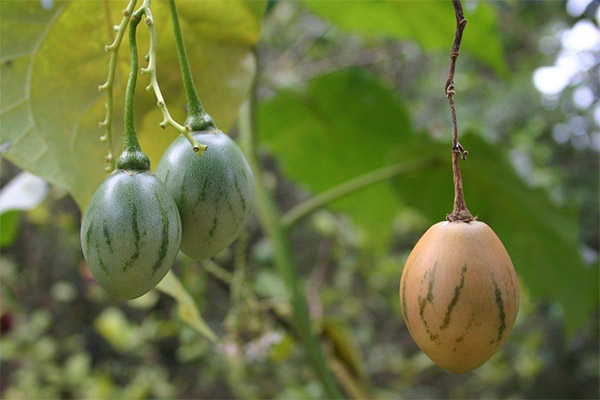
But it is important to follow a few rules:
- It is better to take the seeds out of the fruit only with the help of tweezers. So they will not be damaged. Before sowing, dry them. To increase germination, place in the refrigerator for a day.
- Plant the seeds in a shallow box with fertile soil to a depth of no more than 2 cm. The seedlings will emerge in 2 weeks.
- Transplant the seedlings into individual pots after one month. They should have good drainage. It is important that the pots are not too big. The tree does not have large roots.
- The plants need moist air and good lighting. At the same time, direct sunlight should not be allowed to fall on them, as it is destructive.
- In the hot season the pot with the plant can be put on the balcony or outside.
- Avoid exposure to frost and gusts of wind.
- Water daily. This is best done in the morning, especially when the tamarillo is fruiting.
- Once a week the plant requires fertilization.
Tamarillo grows perfectly well in the open ground even in those conditions which are far from natural. The tree can grow up to 4 m in a plot and bear fruit as early as the second year.
To get a good harvest, you should snip off the dry leaves. Tamarillo is quite unpretentious. With proper care, it can bear fruit for 6-12 years.
Interesting Facts
Such a fruit as the tamarillo has not so long ago become popular in Russia. Only a few years ago, not many people knew about it. But already today the fruit is widely used in cooking. Here are some interesting facts about the fruit of the tomato tree:
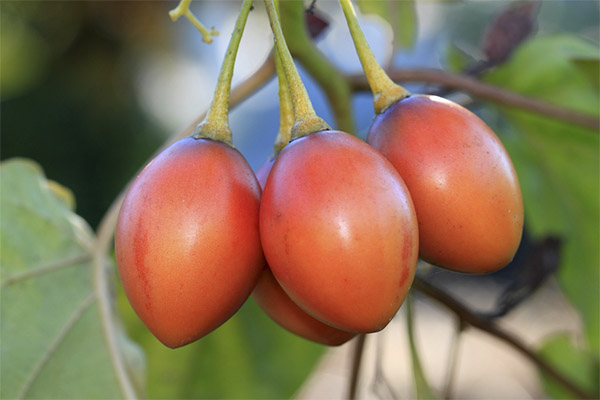
- The name of the fruit was given in January 1967 by a breeder from New Zealand, Thompson. But the fruit has been known for a long time.
- It is believed that the name of the fruit was given for advertising purposes. It helped to attract potential customers.
- Its name was derived from the French word for tama (leader) and the Spanish word rillo. But many scientists think that the fruit got its name from "amarillo". In translation, it means "yellow". This was the color of the fruit of the tomato tree when it was first seen in South America.
- In New Zealand, where tamarillo is very popular, they grow entire plantations of the fruit.
- Even despite large harvests, the product is exported in small quantities. This is due to the fact that tamarillo cannot withstand low or high temperatures, spoils quickly, and does not withstand transportation.
- The product can be stored at room temperature for no more than 5-7 days. It can be kept in the refrigerator for up to 14 days.
- The tamarillo has been known since World War II. The fruit was introduced into the ration of soldiers of the member countries of the anti-Hitler coalition. This is because the product satiates the stomach and satisfies the hunger for a long time.
- Thanks to its effect on the nervous system, tamarillo can relieve headaches caused by nervous tension and disorders.
- Despite its appearance, the product tastes like passion fruit.
- Tamarillo is classified as a fruit. Its closest relatives are potatoes, tomatoes, and eggplants.
- Because of its characteristics, the product can be used not only as a fruit (as an additive to desserts), but also as a vegetable (as part of first and second courses, appetizers and salads).
Tamarillo is a fruit that has a number of unique characteristics. It has the characteristics of both a vegetable and a fruit. This allows it to be widely used in cooking for soups, second courses, appetizers, desserts, and juices.
The composition of tamarillo is quite diverse. The fruit contains a large number of micronutrients and vitamins that are necessary to maintain the work of the body as a whole. But the fruit should be eaten properly. To enjoy its taste, you need to remove the skin. It is quite tough and can spoil the whole impression, especially if tamarillo is consumed for the first time. But it is important to remember that excessive consumption of such an exotic fruit can entail unpleasant consequences in the form of digestive disorders, allergic reactions.
«Important: All information on this site is provided for informational purposes only. for informational purposes only. Please consult with your health care professional before using any of the recommendations. specialist before using any of the recommendations. Neither the editors nor the authors shall be liable for any possible harm caused by materials."

